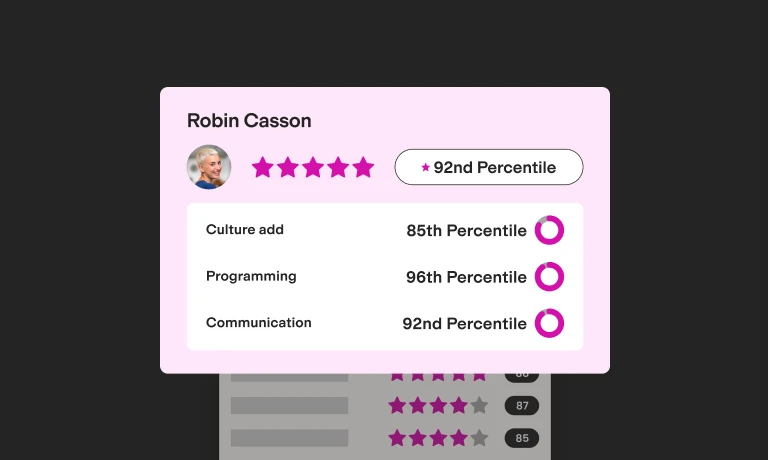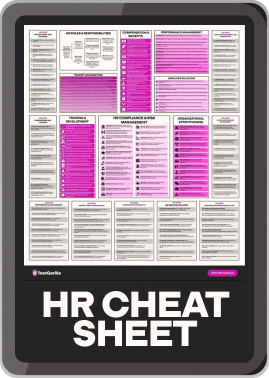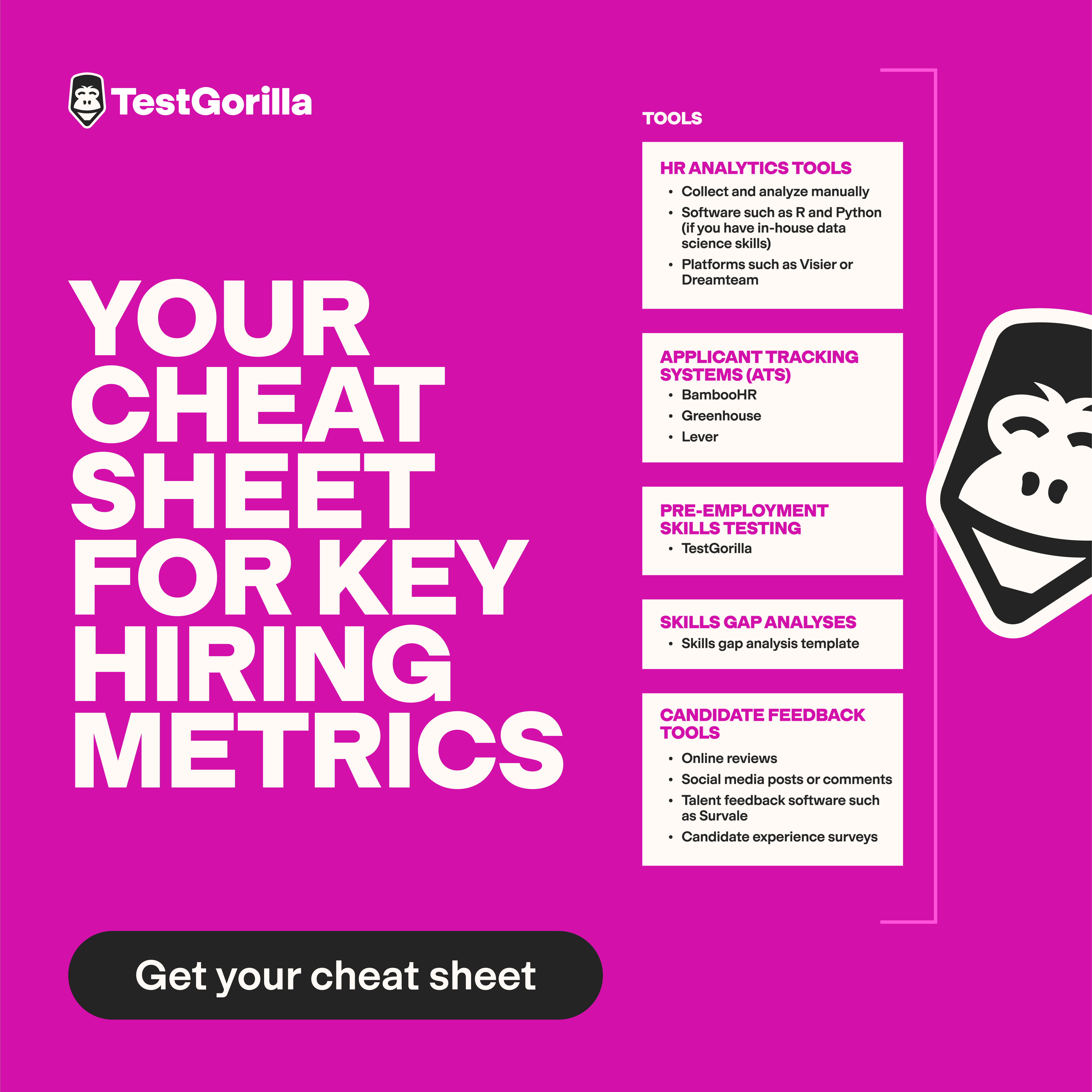8 tricky Scala developer interview questions to ask when hiring
Finding the right Scala developer isn’t easy, especially when you need someone who can write functional, scalable, and production-ready code. That’s where great interview questions come in. The right questions reveal how candidates think, not just what they know.
This guide gives you tricky, targeted Scala developer interview questions to help you go beyond surface-level answers and find real talent. Plus, we discuss how you can screen candidates using Scala coding tests for smarter hiring.
What makes Scala developers tricky to hire
Scala’s hybrid nature – blending object-oriented and functional programming – attracts a wide range of developers, from experienced functional programmers to Java engineers dipping their toes into Scala for the first time. This blend of backgrounds can make it tricky to spot developers who’ve gone beyond toy projects.
Tsvetelina Nasteva, HR Manager at Casinoreviews.net, recalls one candidate who “[froze] when I asked how they’d avoid shared state in a multithreaded scenario using Scala. It wasn’t a trick question – I just wanted to hear whether they’d mention something like Future, or better yet, ZIO or Cats Effect. That tells me where they are in their Scala journey. I’m not checking for buzzwords – I want to know if they’ve actually built anything non-trivial with it.”
Many candidates can write working Scala code – but struggle with core functional concepts like immutability, monads, and higher-kinded types. Others lean heavily on object-oriented patterns, missing out on what makes Scala so powerful in the first place.
What you should evaluate in a Scala developer – and how
A strong Scala developer needs more than surface-level syntax knowledge. Look for a deep understanding of functional programming principles – things like pure functions, immutability, and higher-order abstractions.
Candidates should be comfortable handling concurrency with tools like Future, Akka actors, Cats Effect, or ZIO – and capable of writing type-safe code using pattern matching, sealed traits, and Scala’s expressive type system.
One way to test for this depth is by asking deceptively simple questions that reveal how a candidate thinks, not just what they’ve memorized. Igor Golovko, Head of Development at TwinCore, puts it like this:
“One of my go-to Scala interview questions is: ‘Can you explain the difference between map, flatMap, and for comprehensions, and how they relate to monads in practical terms?
“This isn’t just about terminology – it reveals whether someone actually understands functional programming. A good candidate can show how these tools apply to real-world problems, like composing asynchronous operations with Future or transforming nested data structures in pipelines.”
As he points out, “You can quickly spot the difference between someone who’s read a tutorial and someone who’s built a real reactive system.”
The best insights on HR and recruitment, delivered to your inbox.
Biweekly updates. No spam. Unsubscribe any time.
8 Scala developer interview questions
Here are 8 questions to ask during Scala interviews. We explain why they’re important, plus show you what strong answers look like. We even provide follow-up questions.
1. What’s the difference between val, var, and lazy val in Scala?
Why it’s important: Understanding variable declarations is foundational in Scala. This question reveals whether a candidate respects immutability – a core tenet of functional programming – and understands lazy evaluation, which is often misused or misunderstood.
What a strong answer looks like: A great candidate will explain:
val defines an immutable value that can’t be reassigned after initialization
var is mutable and should be avoided in idiomatic Scala unless absolutely necessary
lazy val delays evaluation until the first time it's accessed (this is helpful for expensive computations or circular dependencies, but should be used carefully to avoid unintended side effects)
They may also note that lazy values are evaluated once and cached – not recomputed each time. Follow-up: “Can you share a time you used lazy val to solve a real-world problem?”
2. Can you explain what a Monad is in Scala and give a real-world example?
Why it’s important: Monads are central to functional programming. This question assesses conceptual understanding, not just memorized definitions. Strong candidates should be able to connect abstract theory with practical, readable code.
What a strong answer looks like: An ideal answer starts by explaining that a monad is a design pattern that allows sequencing of operations while maintaining context. It enables safe chaining of computations (e.g., with Option, Future, Either) while avoiding nested conditionals.
Candidates should highlight:
flatMap and map as the core operations
That a monad must obey three laws: left identity, right identity, and associativity (though not necessarily list them from memory)
A real-world example might be using Option to handle missing data:
val maybeUser = getUser(id)
val maybeEmail = maybeUser.flatMap(user => user.email)
Another example is using Future for asynchronous workflows. Follow-up: “What happens when you flatMap an Option that returns None inside a for comprehension?”
3. How does Scala handle concurrency, and how do you manage side effects in concurrent code?
Why it’s important: Concurrency is where good Scala developers distinguish themselves from others. This question surfaces both technical knowledge and architectural thinking, which are vital for roles involving back-end, data, or distributed systems.
What a strong answer looks like: Strong candidates explain that Scala handles concurrency primarily through:
Futures: For lightweight, non-blocking, asynchronous tasks
Promises: For creating and fulfilling Futures externally
Akka: For building actor-based systems where state is managed via message passing
Cats Effect / ZIO: For purely functional, effect-managed concurrency
They should mention:
Avoiding shared mutable state
Using functional constructs to model side effects (e.g., IO monads)
Keeping side-effecting code at the edges and using referential transparency in core logic
Give them bonus points for discussing:
ExecutionContext
Blocking vs non-blocking operations Structured concurrency in modern effect systems
Follow-up: “How would you refactor a blocking I/O API to work within a non-blocking Future or IO context?”
4. What’s the difference between map and flatMap for comprehension in Scala?
Why it’s important: These are core tools in functional programming and monadic chaining. Candidates often use these without fully understanding the differences. This question helps you identify who really “thinks in Scala.”
What a strong answer looks like: A strong candidate will explain:
map applies a function to each element, returning a wrapped result (e.g., List[A] → List[B] or Option[A] → Option[B])
flatMap is used when the transformation itself returns a wrapped type (e.g., Option[A] → Option[B]) – it flattens the result to avoid nested structures like Option[Option[T]]
for comprehensions are syntactic sugar over chained flatMap and map calls – they're useful for sequencing multiple operations clearly
Follow-up: “When would you not use a for comprehension, and why?”
5. How would you refactor imperative code using functional constructs in Scala?
Why it’s important: This is a litmus test for functional fluency. You’re looking for developers who can think in transformations rather than mutation and loops – a must for writing testable, maintainable Scala.
What a strong answer looks like: Top candidates should:
Emphasize immutability (no var, no mutable collections)
Use higher-order functions like map, filter, fold, reduce, or collect
Avoid side effects inside loops – separating logic from I/O
Here’s an example of imperative code:
scala
CopyEdit
var sum = 0
for (i <- list) {
if (i % 2 == 0) sum += i * i
}
Here’s an example of how this can be refactored functionally:
scala
CopyEdit
val sum = list.filter(_ % 2 == 0).map(x => x * x).sum
Give candidates bonus points if they mention:
Benefits to testability
Easier reasoning and debugging
Encouraging composition
Follow-up: “How would you handle a large dataset functionally without blowing up memory?”
6. What is tail recursion, and when should you use the @tailrec annotation?
Why it’s important: Recursion is common in functional languages, but naïve recursion can crash a system if not written properly. This question evaluates both theoretical understanding and practical performance awareness.
What a strong answer looks like: Great answers explain:
Tail recursion is a form of recursion where the recursive call is the last operation in the function – no work is done after the call returns
The Scala compiler can optimize tail-recursive functions into loops, making them stack-safe
The @tailrec annotation ensures the compiler checks that the method is actually tail-recursive – and fails if not
Candidates may also touch on:
Why tail recursion avoids StackOverflowError
When it's better to use collection methods or loops instead
Follow-up: “What happens if you leave off the @tailrec annotation and your method isn’t actually tail-recursive?”
7. Explain pattern matching in Scala and how it differs from switch-case in Java.
Why it’s important: Pattern matching is one of Scala’s most powerful tools. It enables you to destructure complex data and model control flow more expressively than Java-style conditionals. This question tests the candidate’s ability to reason about data structures idiomatically in Scala.
What a strong answer looks like: An excellent candidate will explain that:
Pattern matching goes beyond switch statements – it works not just on primitives but also on case classes, collections, tuples, and even custom extractors
It enables decomposition of data while simultaneously executing logic
Matching is exhaustive, and the compiler can warn you if not all cases are covered (especially with sealed traits)
Candidates should emphasize the role of case classes and sealed traits for safe, expressive pattern matching.
Follow-up: “What’s the risk of pattern matching on unsealed class hierarchies?”
8. How do implicits work in Scala, and what are the potential pitfalls?
Why it’s important: Scala’s implicits are one of its most powerful – and misused – features. This question separates thoughtful Scala devs from those who just follow framework conventions without understanding them.
What a strong answer looks like: Here’s what strong candidates’ explanations will include:
Implicit parameters allow the compiler to inject arguments automatically when not provided explicitly
Implicit conversions allow automatic type coercion – but can lead to unexpected behavior if overused
Implicit classes let you add methods to existing types (a common pattern in DSLs or extending libraries)
Candidates should mention the importance of clarity, scoping, and the rule that the compiler searches in two places: local scope and companion objects.
Give interviewees bonus points if they bring up type classes or compare Scala 2's implicit with Scala 3's given/using.
Follow-up: “Have you ever seen implicits make debugging harder? How do you avoid that?”
Common red flags in Scala interviews
Be cautious of candidates who fall into these patterns – they often signal shallow understanding, limited real-world experience, or a tendency to misuse key Scala features:
Treats lazy val as just a performance trick without recognizing its impact on side effects
Says, “A monad is just a container”
Says, “Just use Thread.sleep or synchronized blocks”
Says for loops are just like in Java or Python
Says, “functional is slower” without considering context or optimization
Doesn’t distinguish between tail-recursive and normal recursion, or thinks the annotation is just for documentation
Only references matching on integers or strings
Says, “they’re (implicit values, conversions, and classes) just like default parameters” or advocates using many implicit conversions
Combine interviews with code assessments
Even the best interview questions can only take you so far. A candidate might talk fluently about monads or Futures – but can they write clean, performant Scala code under real conditions? To ensure they can, you should use hands-on coding assessments.
We recommend screening candidates with targeted code challenges – like functional refactoring exercises, concurrency simulations, or pattern-matching tasks. Real-time problem solving in a secure, timed environment helps reveal how someone approaches real-world scenarios.
TestGorilla supports customizable Scala coding assessments, so you can screen candidates for exactly what your team needs, then shortlist top-scoring ones for your interview. (You can even add custom questions – including the questions above – to your assessments.)
Confidently hire Scala developers who are production-ready
Strategic interview questions reveal how candidates approach problems. And pairing those questions with hands-on, role-relevant code assessments is how you truly identify top-tier talent.
TestGorilla helps you do both. With customizable Scala tests and functional programming scenarios, you can screen early, hire smarter, and move faster. Explore TestGorilla’s test library or book a demo to see it in action.
You've scrolled this far
Why not try TestGorilla for free, and see what happens when you put skills first.




















